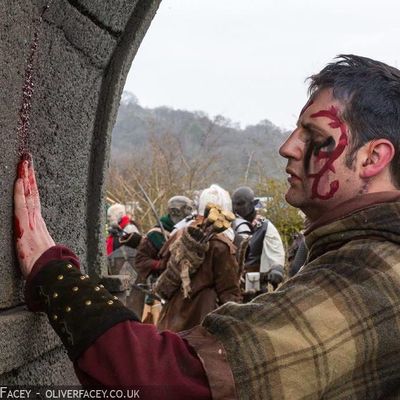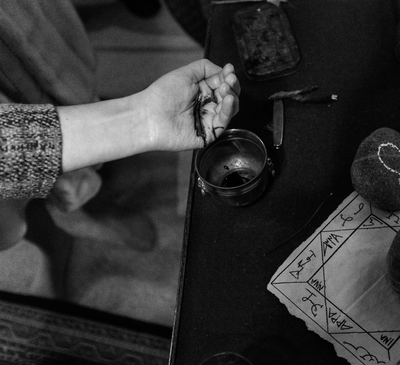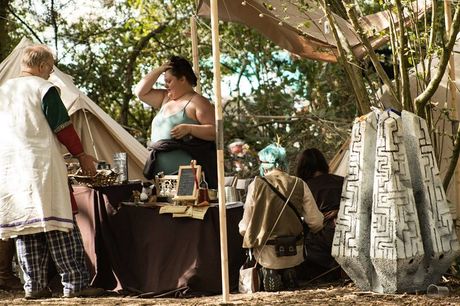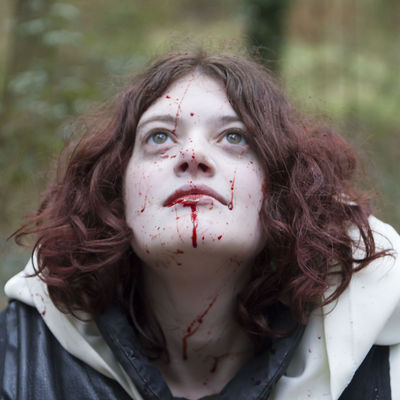Blood magic

Overview
Blood magic is a primeval tradition whose history firmly predates the creation of the Empire. It can be found in the magics of the Terunael wizards; many of their artifacts show the grooves where blood once ran, and items recovered from their fallen cities include ritual knives and ceremonial bowls. In current times, it remains the most popular form of ritual magic in the Navarr, but there are practitioners of blood magic in every land.
Using blood magic in a ritual casting is about much more than a magician just cutting themselves. The source of the blood is one of the most significant elements; it draws on the nature and character of the donor acting as a mystical fount for the magic that follows, grounding it and giving it purpose. Where the body is cut is also important and how the magician stores and handles the blood has deep symbolic meaning. These three components are usually referred to as the source, the cut and the method.
Blood magic is clearly simpler than more complex traditions, like dramaturgy, or astronomancy; whether this is seen as a weakness of the tradition - or a strength - tends to depend on a magician's approach to magic.
As with all magical traditions, magicians do not have to use blood magic if they don't want to. This is a magical framework that magicians can use to add significance to their rituals, not a prescriptive list of elements that will cause a ritual to fail if they are not included.
Theory
Blood magic works because of the connection between a person's living blood and their fundamental nature. While magicians argue over the precise nature of this connection, whether or not it reflects a person's soul or something less spiritual, what is inarguable is that the blood holds a mystical link to the essential qualities of a person. When blood is spilled, (or indeed other bodily humours; specifically sweat and tears), it is possible to create magic that draws on the essential qualities of that person - and also to form mystical bonds with them.
Practitioners of blood magic teach that significant events that impact an individual are also present in some way in their blood, as are their connections to one another. The blood of lovers is notoriously powerful, for example, and blood magicians believe that the strength of their affection for one another is contained or echoed in the blood, as is the bond between siblings and that of a parent and child. Of particular interest in the latter case is that blood magic teaches that the strength of the bond between family members is echoed in the blood even when a sibling or child is adopted. This link between a person and their blood works both ways - the magician can use the blood to fuel the power of their magic with the essential qualities of the owner. But they can also use the blood to create links and bonds to that person.
Dried or preserved blood has no power. Whatever essential qualities blood possesses are soon lost once the blood has been spilled.
Procedure
The Source
The power of blood magic reflects the nature of the person from whom the blood comes. Their lineage, their faith, their history and their temperament can all be invoked as part of the magic using their blood as a medium to these essential elements. Blood magic can draw on the physical nature of the source; for example blood from a lineaged individual will increase the link to that realm, as their blood literally contains the magic of the realm. There are also rituals that are associated with the intrinsic nature of the different lineages. When casting the Twilight Masquerade, it is common to use blood from a person of the lineage that the target will "become".
Blood magic techniques are most relevant when creating personal magic that will affect the participants. Rituals that affect groups of people, will commonly use blood from each of them, often combining it together during the ritual (especially if the ritual is an enchantment, or the magic is intended to create a bond between them). Abstract magic, such as rituals to enchant resources are harder to accomplish with blood magic, unless the magician can invoke a connection between the blood that is present in the ritual and the blood spilled to gain or work the resource.
Blood magic excels at curses, fuelling the power of the magic with the desire for vengeance in the giver's heart. To cast a curse the blood should come from the wronged party, potentially mixed with the casters. It is the strength of feeling of the wronged party, coursing through their blood, that powers the curse to affect the target of their wroth.
Blood is almost never taken from unwilling participants by Imperial magicians. Although it is claimed that some of the Druj use blood from their enemies to create their curses, there are many cautionary tales about the use of blood from unwilling targets having dire consequences with magics rebounding on the casters. Since the time of Empress Teleri, the Synod and Conclave have agreed that such practices are as dangerous as they are dubious and the Navarr vates have encouraged both to hand out heavy punishments to those who attempted it.
Although magicians will usually only draw blood in their rituals, there is a metaphysical link between blood, sweat, and tears at the heart of this tradition. Blood is certainly the most potent "humour", but Marcher magicians in particular draw a link between sweat and physical labour, toil, or striving. Likewise, magicians from several nations point to the symbolic power of tears to harness the power of grief, sorrow, or regret in the same way that drawing blood draws on the suffering of the donor to create a curse. A tradition of Highborn magisters associated with the Litharge, for example, are known to use the tears of grieving family members as part of their performance of Whispers through the Black Gate.
The Cut
The part of the body where the blood is taken from can have different significance for the magic it is used in. Blood is most commonly easily taken from the palm or the wrist, but for some rituals it is more effective to make the incision at a particular point on the body.
Magic to create bonds or oaths are most commonly performed using blood drawn from the open palm. In some cases participants may shake hands or touch palms that have been cut to allow blood to mingle, or the magician may collect together the blood of several participants to bond them to each other - dripping the blood from a cut palm or clenched fist into a container. If the magic involves items or structures that are present, the open wound is often pressed to the item, smearing it with blood or leaving a bloody hand print.
Rituals involving contracts or writing - especially those using Autumn magic - are often signed with blood; in these cases it is common to take blood from a thumb or finger. The blood usually comes from the signatories, but sometimes cambion blood is used to write the contract, or as part of a mixture with the participant's blood. A bloody thumb print or a name or text written in blood drawn from the thumb is very popular way of performing these rituals, even among magicians who do not otherwise practice blood magic.
Rituals that enhance the personal strength of the target, especially Summer enchantments more commonly involve cuts to the outside of the arms or to the torso. These may be done slowly and ceremonially - to reflect drawing the giver's strength, or with a swift cut to simulate the blood spilled from a battle wound. These cuts are often deep, so a chirurgeon may be on hand to clean and bind the wound once the blood is drawn. These cuts are potent where the strength or fortitude of the donor is to be enhanced, with rituals such as Unbreakable Behemoth's Strength; or where they are to be tested, with rituals like Challenge the Iron Duke.
A few rituals, especially those that change or hide the nature of the target such the Twilight Masquerade, are best performed using a shallow cut to the face, usually to one or both cheeks. Such cuts are not dangerous, but they are usually cleaned and treated so that they will heal without scarring - though a handful of magicians maintain that scars can make the magic that results more powerful. For some night divination rituals, the magician will use a tiny knife to make a cut on the brow above one or both eyes - in this case it is common to allow the blood to run down from the cuts.
Rituals intended to enhance the skill or wisdom of the target, such as Might of the Myrmidon, sometimes involve cuts made with the point of a knife to the back of the hand. Such cuts require great care to avoid harming the sinews of the hand, the more care the magician takes in making the cuts, the more effective the magic.
The Method
Once the blood is drawn, what the magician actually does it is an integral part of the ritual, and helps shape the desired effect. Rituals to protect the target are generally performed by smearing some or all of the blood on the target, usually the body or the face if they are a person, or on a keystone, lintel, or foundation in the case of a structure. Some magicians will draw patterns, sigils, or runes over a body, item or area; some prefer to leave more primal bloody smears or hand prints. The drawing of patterns in blood is the strongest element in Navarri magicks because it links the tradition of blood magic with their hearth magic of tracing patterns; it is also seen among the Varushkan cabalists, sometimes echoing the designs found on the painted caves of Miekarova This method is also used to draw runes that activate, empower, or open things by drawing patterns on them.
Rituals to empower a target also involve contact with the blood but usually by anointing rather than smearing or painting the blood on to them. The blood may be mixed with something else (pure water or wine are common examples), and where the blood is anointed will help strengthen the themes of the ritual - for example, the forehead or eyes are marked when a ritual is intended to give someone keen sight or mental capabilities.. Anointment is the most common use of blood when a solo caster is also the target, for convenience reasons if not for any magical significance. Anointment is also commonly used in healing rituals where the caster's blood is used to anoint the person being healed.
Rituals that involve personal transformation or good fortune of some kind may call on the target to drink the blood. A handful of participants appreciate the bravado of making a great show of drinking a mouthful of blood, but most serious magicians understand that it is the symbolism, not the volume that matters. A simple taste is perfectly adequate to perform even the most powerful magic, and avoids the ritual being ruined if the target cannot keep down what they have imbibed.
Divination is commonly performed by dripping or pouring blood in a pool of water, or scattering blood onto parchment or a similar surface, and interpreting the patterns that result. Often blood is also poured on a map with the magician drawing insight from the patterns that the blood makes as it runs across the map. If blood is mixed from a large number of sources then it is possible to scry by staring into the blood itself - in such cases a ritual bowl or chalice may be used. Some magicians will taste the blood and use that to information to determine information about the target; this is often a way that is used to find out about curses on a person with rituals such as Wisdom of the Balanced Blade.
Enchantments designed to affect a band, be it a coven, sect or banner often involve combining the blood of all the participant, usually mixed in a goblet or chalice and then either drunk or used to anoint the participants.
A libation is common in rituals that affect large areas (especially those that affect a territory, or a regio), or those who dwell therein. Libation can also be used to show disdain for a person, however. For example, during blood magic curses, the ideal is to convey the blood to the victim of the curse, and pour it on the ground at their feet. Ideally the blood of the wronged party is drawn in the ritual and then spilled on the ground in front of the person as the pronouncement of doom is made.

Blood Magic in the Empire
Blood magic is most common amongst the Navarr, especially the vates. All blood magic has a powerful synergy with hearth magic of sacrifice, and some Navarr use it as a symbol of the blood of the Empire. Most use it to reference the sacrifice that Navarr and Thorn made when they created the trods. Blood magic is sometimes referred to as Navarri magic, as it is common and openly accepted here and several nations encountered it for the first time among the stridings.
Blood magic has a less sanguine reputation in Varushka, where it is commonly associated with dark pacts employed by sovereigns. Its use is still common, despite this unsavoury association, especially among covens that seek to gain the favour of sovereigns to try to control the wolves and keep them away from those they love. Some Varushkans claim that the Ushkans were the original creators of blood magic - and that they taught it to the Navarr - though there is scant evidence to support these claims. In Varushka particularly, the blood of family members is said to have particular potence - when healing a sick child a Varushkan volhov who is a practitioner of blood magic may draw the blood of the parents and even grandparents of the target, hoping to grant their health and strength to their child. The age of the donor is also seen as more relevant than in other blood magic traditions - wisdom and insight is found in the blood of the old, strength and security in the blood of adults, and vitality and transformation magic may benefit from blood donated by a child.
Amongst the Imperial Orcs, blood magic remains somewhat contentious. Some orcs claim that blood magic is the original magic of the orcs - some shamans claim that it can call on the power of the ancestors - whose blood flows through those present. According to some older orcs, in the early days of the Orc Rebellion, blood was regularly used as the only tool available to draw symbols or sigils, and they talk freely about primitive rituals that combined the blood of warriors together to provide strength and endurance to the rebellious slaves. Today, the more progressive covens argue that blood magic is uncivilized, a hallmark of the primitive past that the Navarr have been unable to give up - others are offended by the connection to the savage bloodletting practiced of the Druj - and embrace different, more Imperial, traditions.
Blood magic is more rare in the Brass Coast, but there are some hakima who use tiny amounts of blood to create powerful Autumn magicks. These covens use the blood of the signatories to empower their contracts to make them binding - or to invoke fell consequences for treachery.
Most Urizen dislike blood magic, as much from their deep-rooted cultural taboo about touching as anything else. It is used primarily in rituals to divine information about a person, or in magic that creates bonds between close friends or family members, and largely eschewed otherwise. Those who do adhere to this tradition are usually keen to focus on the magical power innate to the blood of the lineaged, although a few spires have unsavoury reputations for proselyting the "superior quality" of the blood of magicians over that of non-magicians.
Blood is also used by some artisans as part of the crafting process of certain magic items, to add power or to create an innate link between the artisan and their creation. Items such as the Blood-sweat Hauberk, the Robe of Blood and Bone, or the Corsair's Bloody Mask may all employ blood magic in their creation. Artisans who favour the use of blood magic will also mix a drop of their own blood with a little of the blood from a target when bonding an item to a new recipient.
Blood Magic and the Imperial Faith
Only a few members of the Imperial Synod openly accept the idea that a person's soul is in their blood, although more are receptive to the idea that the blood is a medium by which a magician can touch an individual's soul. In the early years of the Empire there was a great deal of discussion of the probity of blood magic, whether or not such influence was appropriate. Eventually the Synod took the view that there was ultimately no difference between using magic to influence a person's soul and using mundane words. A magician who performs Unbreakable Behemoth's Strength on a citizen will influence their soul for a few days - but a priest who convinces a pilgrim to pursue the path of Prosperity will change their soul forever. What mattered, it was decided, was not the method of interaction with the soul - but the outcome.
Thus the Synod traditionally does not oppose the practice of blood magic, provided the source is willing and cognizant of what is happening. Only the use of violence - taking blood by force - is condemned. Fortunately this view accords with the approach of the Conclave who argue that only willing blood can form a harmonious element of magic, and that attempts to coerce the soul of a victim to participate in magic are certain to rebound on the caster in ways that are unpredictable and dangerous.

Singing Stones
Of particular interest to many blood magicians are the so-called Singing Stones of ancient Terunael. Extremely rare, these relics are especially sought after by Navarr magicians for obvious reasons. Only a handful have been uncovered, and the process of creating them is little understood. Each seems to be unique; no two are precisely the same. There are some similarities between those that have been uncovered so far. Each stone takes the form of four angle columns joined at the base. They tend to be between four and five feet tall, made of stone, and carved on all sides with angular patterns somewhat reminiscent of the labyrinth marks common on the skin of many cambion. These angular designs are common to many artefacts of Terunael - and somewhat at odds with the curved, sweeping patterns associated with the Navarr. The arrangement of columns allows a carefully constructed bowl to be placed atop the singing stone in such a way that the contents will slowly run down the carved designs along each column. The obvious intent is that a bowl of blood with four precisely placed holes would bathe the entire stone over the course of a ritual performance.
What sets the singing stones apart from other Terunael structures, however, is that they appear to sing. Each stone encountered so far has its own, barely audible, distinct song. The music becomes a little clearer when one is physically touching the object, or when it is bathed in blood as part of a blood magic ritual. Each song is difficult to describe, but often leaves listeners reporting sensations of disorientation or unease.
The stones encountered by Imperial archaeologists to date have shared a similar property; they allow multiple covens from the same nation to cooperate on the performance of a specific ritual in a manner similar to a Web of Celestial Attunement, or the archmage's Belt of Stars. Unfortunately for modern magicians, most of the stones uncovered so far have been intended for rituals unknown to Imperial lore. Although their effects can be surmised, the stones appear so precisely made that they require exact formulaic rituals to be of any use.
A larger variant of the singing stones has been encountered by explorers in Terunael ruins are immobile. Unlike their shorter counterparts, attempts to relocate them invariably end up destroying their magic. Most of those encountered were already inert, damaged beyond repair by the passage of time and the vallorn. Ifan Redwater, who made a study of one of these obelisks uncovered in the ruins of Seren theorised that the larger stones are intended to work in some fashion with the local flows of mana, not entirely dissimilar to the standing stones that dot the Marches. The obelisk in the ruins of Seren had the property of allowing multiple covens to co-operate on a ritual of Autumn magic intended to ensure a good harvest for the farmers of the territory, with a ritual similar to Gathering the Harvest. Whatever the precise details of the ritual, it proved impossible to use the stone in conjunction with Gathering the Harvest. According to further research, another three obelisks of similar size once stood in the same location, but long years and the destructive nature of the vallorn had shattered them. Ifan Redwater tentatively speculates that they were intended for use with three other rituals similar in nature to Blessing of New Spring, Strong Ox, Golden Sun, and Fallow Fields and Dried Meat.
OOC Note
Please do not apply phys-rep blood substitutes to a player's skin or costume, without ensuring beforehand that you have their permission to do so.
